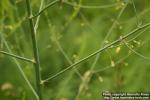 The young shoots and roots of the Asparagus officinalis, Linné.
The young shoots and roots of the Asparagus officinalis, Linné.
Nat. Ord.—Liliaceae.
Botanical Source.—The asparagus is a perennial plant, with an erect, round, unarmed, very branching, herbaceous stem, from 2 to 4 feet high. The leaves are setaceous, flexible, filiform, and fasciculate, from ½ to 1 ½ inches long, and of a pale-green color. The flowers are axillary, small, and greenish in color, either solitary or in pairs, and are succeeded by handsome red berries, which are globose and three-celled, each cell containing 2 seeds.
History and Description.—This herb is indigenous to Europe, and is extensively cultivated there, as well as in the United States, as an article of diet. The root has a faintly saccharine flavor, but no odor, and is active only when in the recent state. It is a short rhizome, from ½ to ¾ inch thick. Stem-scars mark its upper surface, while from beneath many long white roots are given off, which become longitudinally furrowed on drying. The fresh roots were formerly much more used than at present, though they are still used by the French. The young shoots, which are employed as an article of diet by many, have a disagreeable taste, which is removed by boiling with water.
Chemical Composition.—Vauquelin and Robiquet (1805) found in the juice, asparagin (C4H8N2O3.H2O), which crystallizes in right rhombic prisms, is odorless, and without taste, and refuses to dissolve in alcohol and ether. The same principle is found in other plants, notably althea, in which it was found by Bacon in 1826; also mannit, oleoresin, wax, albumen, salts, etc.
In 1870 Reinsch discovered glucose in the berries and an orange-red coloring principle, sublimable and crystallizing as scales from ether, to which the name spargancin has been given. The seeds contain sugar, fixed oil, a fragrant resin, and a bitter body, spargin, capable of crystallization.
Action, Medical Uses, and Dosage.—Both the fresh roots and shoots act as diuretics, communicating an unpleasant odor to the urine. A syrup is prepared by adding sugar to the expressed juice, deprived of its albumen by heating and straining, or an extract may be prepared from them by evaporation of the juice to a semi-solid condition. The dose of the former is from 2 to 3 fluid ounces; of the latter, from 30 to 60 grains. They are said to cause copious diuresis, and are reputed very beneficial in repressing undue excitement of the circulatory system, and have been used with advantage in enlargement of the heart, dropsy, etc. It is said that asparagus shoots may produce irritation of the urinary mucous surfaces, attended with a morbid mucorrhoea.

